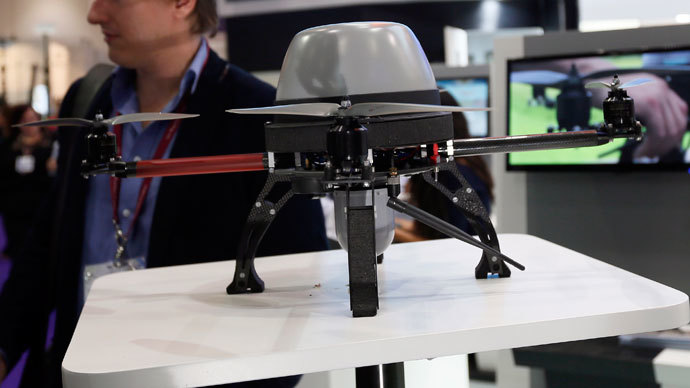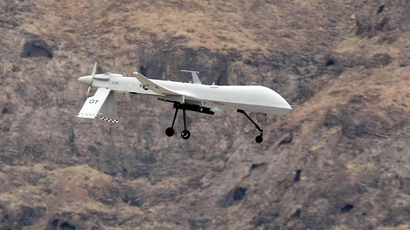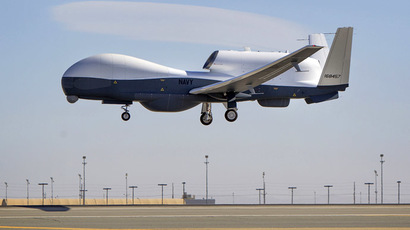Future war: Arms industry shows off next-gen drones in London

Reconnaissance gadgets and robotic warfare devices are getting smaller by the year, with James Bond like technology being offered to a wide range of buyers, from police forces to special military units.
The market place for such technology has become Defence Security
and Equipment International (DSEi) exhibition held at ExCel
London.
The international exhibition has established itself as the
leading platform to view and purchase state of the art equipment
from the world’s defense and security industry. Held from
September 10-13, it showcased 1,391 exhibitors to almost 30,000
visitors from 121 countries.
This year, the Unmanned Aerial Systems (UAS) conference was also
held as part of the DSEi and has focused on future capabilities,
including civilian applications of drones as well as
technological innovations. The UAS 2,000 m2 event became a
one-stop store for anyone seeking to work with the Remotely
Piloted Air Systems industry. The Unmanned Systems Showcase held
number demonstrations of Unmanned Aerial Vehicles (UAVs) and
Unmanned Ground Vehicles, as well as other gadgets that are to be
deployed in various security environment and scenarios.
“Technological advances, operational imperatives and budgetary
constraints are driving ever greater reliance on UAVs in military
operations. UAVs are increasingly being depended upon to deliver
capabilities that formerly relied on manned platforms. As
their strategic importance increases, the UAS industry must
respond to deliver systems that are ever more cost effective,
dependable and survivable,” one of the sponsors of the event,
Cranfield University, said at the conference.
As unmanned drones continue to make headlines on the battlefield
in the US-led war on terror over the skies of Afghanistan, Yemen
and Pakistan, the industry’s main goal is to expand the market
share of robots to law enforcement and other security industries.

American companies such as Lockheed Martin, Northrop Grumman and
General Atomics continue to dominate the military market, while
other defense firms such as BAE Systems are in pursuit to develop
the next-generation drones with stealth capabilities.
But it is the smaller players on the market that are expending
the robotic frontiers with their drive to perfect underwater
robots that can that can be used on the seabed to clear mines or
gather reconnaissance. The inventions are getting so tiny
that a newly exhibited "quadrocopter" with four or more rotors
can be activated from backpacks via remote control.
One of the aim of the technological innovations is to make
warfare more secure and safe.
For instance, the ReconRobotics firm says their latest product,
the ThrowbotXT is designed to detect an explosive or hostiles in
a building before soldiers or police are sent in to secure the
premises. The company has sold more than 4,000 of these devises,
mostly to the US military in Afghanistan.
The personal sensor system for tactical operators is
“pound-for-pound, the most versatile, robust, stealthy and
easy-to-deploy tactical robot system in the world,” the company
says.
Once deployed, the micro-robot transmits video and audio to the
controller allowing the analyst to “spot armed subjects, confirm
the presence of hostages or innocent civilians, listen in on
conversations, and reveal the layout of rooms”
"It gives you eyes inside a room before you go there,"
Ernest Langdon director of US and international military programs
for the company told Reuters. "Maybe that means you see there
are children in a room so you don't throw a grenade. Maybe it
means you find an IED (improvised explosive device)."

ReconRobotics' is in the process of developing a flying quadrocopter tiny enough to fit in a backpack but capable of providing surveillance inside a structure. Similar designs were also showcased by Estonia's Eli Airborne Solutions used by the country’s border guard and aimed for exports to Latin America countries.
Other companies such as the British Colena, are trying to break
into a non-military market and are targeting show business. Their
five-rotored radio-controlled copter is designed to for the use
of film production studios by offering views over battlefields
and facial recognition software to scan crowds at public events.
"You see it at the end where you have small robots to be
thrown through a window and you see it at the higher end where
you have large, expensive drones with artificial intelligence
designed to operate for hours or even days at a time,”
Douglas Barrie, air power analyst at London's International
Institute for Strategic Studies told Reuters
“This UK MOD initiative aims to facilitate pragmatic and
expedient test and evaluation solutions to a wide range of
emerging issues ranging from operational capability problems
through to studies pertaining to future UAS test and
evaluation,” Defence Unmanned Air Systems Capability
Development Centre said about the exhibition.

This year’s event has been highly politicized as major powers
lock horns over the US’s attempt to strike Syria over the alleged
use of chemical weapons. But it was not the US, responsible for
massive collateral damage from the drone warfare that was under
pressure. Instead, it was Russia, which the organizers thought
should have a limited space for presentation at the event, due to
its military contracts with the Syrian government.
“We can confirm categorically that Rosonboronexport is not
exhibiting at DSEI 2013,” organizers said in a statement. As
a result, only five Russian companies were registered to exhibit
that are classified as humanitarian and rescue organizations.
They include EMERCOM - an Russian organisation engaged in
humanitarian and rescue activity around the world; Concern
SYSTEMPROM - manufacturers of communication and control systems;
Kovrov Electronmechanical Plant - manufacturers of bomb disposal
robots, electrohydraulic systems for stabilisation, and GPS
systems; MDB COMPAS - manufacturers of navigation equipment for
aircraft; and RPC ISTOK - manufacturers of microwave
communications components.
Because many of the exhibitors were from the arms industry, the
event attracted a throng of anti-war and anti-drone protesters.
Arguing that robotic warfare eliminates ethical factor in combat
by making it too easy to kill innocent people, hundreds protested
next to Excel centre for the duration of the conference.
The rally, titled “Say No to the Games of Drones”, was
organized by War on Want, Campaign Against Arms Trade, Drone Wars
UK, Stop the War Coalition and Campaign for Nuclear Disarmament.
“Drones are indiscriminate weapons of war that have been
responsible for thousands of civilian deaths. Drones should be
banned, just as landmines and cluster munitions were banned. Now
is the time to stop the rise of drone warfare - before it is too
late,” War on Want said in a statement.
Armed drones were first used in late 2001 by Washington inside
Afghanistan. Since then, drones have been deployed by the US and
its allies in Pakistan, Yemen, and Somalia. It is estimated that
the United States has killed around 4,700 people in drone
strikes.














